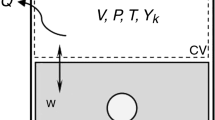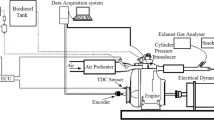Abstract
Premixed charge compression ignition (PCCI) is one of the most important strategies of low-temperature combustion, in which a high level of EGR can be employed to reduce the combustion temperature and to extend the ignition delay period. Due to low-temperature combustion, these engines have low exhaust NOx but the CO and UHC emission levels are high. One approach to control these emissions in PCCI combustion is the use of biodiesel fuel because of its different physical and chemical properties compared to that of diesel fuel. The purpose of the current study is the optimization of the combustion, performance and emission characteristics of biodiesel-fueled PCCI engine using the design of experiments (DOE) methodology and a 3D CFD model coupled to a semi-detailed chemical kinetics mechanism. The chemical kinetics mechanism contains 69 species and 192 reactions. After validation of the model, the effects of five parameters including the start of injection, fuel injection pressure, exhaust gas recirculation, swirl ratio, and biodiesel content on PCCI engine performance and emissions are studied. The parametric study results are analyzed to find the upper and lower levels of DOE study. Then, the importance of each parameter, as well as their interactive effects on the performance and emissions, is determined using the DOE method. The results of the parametric study indicate that the most important parameters affecting the engine IMEP and exhaust HC, CO, and NOx emissions are EGR and SOI, respectively. Meanwhile, the results of the DOE study show that the interactive effect of EGR and SOI has the most significant impact on engine performance and emissions. Hence, to achieve the highest IMEP, EGR should be at its highest level and the fuel should be injected as early as possible. Also, earlier fuel injection and lower EGR percentages should be employed to reduce HC, CO, and soot emissions.





































Similar content being viewed by others
Abbreviations
- AMR:
-
Adaptive mesh refinement
- aTDC:
-
After top dead center
- ANOVA:
-
Analysis of variance
- BDC:
-
Bottom dead center
- bTDC:
-
Before top dead center
- CAD:
-
Crank angle degrees
- CA50:
-
Crank angle of 50% heat release
- CFD:
-
Computational fluid dynamic
- CHR:
-
Cumulative heat release
- CI:
-
Compression ignition
- CR:
-
Compression ratio
- DOE:
-
Design of experiments
- EGR:
-
Exhaust gas recirculation
- EVO:
-
Exhaust valve opening
- FIP:
-
Fuel injection pressure
- GM:
-
General motors
- HCCI:
-
Homogeneous charge compression ignition
- HRR:
-
Heat release rate
- ID:
-
Injection duration
- IMEP:
-
Indicated mean effective pressure
- ISFC:
-
Indicated specific fuel consumption
- IVC:
-
Intake valve closure
- LTC:
-
Low temperature combustion
- PCCI:
-
Premixed charge compression ignition
- RCCI:
-
Reactivity controlled compression ignition
- ROPR:
-
Rate of pressure rise
- SI:
-
Spark ignition
- SOC:
-
Start of combustion
- SOI:
-
Start of injection
- TDC:
-
Top dead center
- VCR:
-
Variable compression ratio
- VGT:
-
Variable geometry turbocharger
- CO:
-
Carbon monoxide
- CO2:
-
Carbon dioxide
- C7H16:
-
Normal heptane
- C14H30:
-
Tetradecane
- DEE:
-
Diethyl ether
- HC:
-
Hydrocarbons
- O2:
-
Oxygen molecule
- NOx:
-
Oxides of nitrogen (NO + NO2)
- SME:
-
Soy methyl ester
- UHC:
-
Unburned hydrocarbons
References
Imtenan S, Varman M, Masjuki H, Kalam M, Sajjad H, Arbab M, Rizwanul Fattah I. Impact of low temperature combustion attaining strategies on diesel engine emissions for diesel and biodiesels: a review. Energy Convers Manag. 2014;80(3):29–56.
Awate SP, Bhangare SB, Deore DS. Homogeneous charge compression ignition engines. IJETT. 2014;1(1):129–34.
Boot M, Rijk E, Luijten C, Somers B, Spray impingement in the early direct injection premixed charge compression ignition regime, SAE technical paper 2010–01–1501, 2010.
Boot M, Luijten C, Somers L, Eguz U, Erp D, Albrecht A, Uncooled EGR as a means of limiting wall-wetting under early direct injection conditions. SAE technical paper, 2009.
Cinar C, Özer C, Sahin F, Yuces HS. Effects of premixed diethyl ether (DEE) on combustion and exhaust emissions in a HCCI-DI diesel engine. Appl Therm Eng. 2009;30:360–5.
Colban W, Miles P, Effect of intake pressure on performance and emissions in an automotive diesel engine operating in low temperature combustion regimes, SAE paper, 2007–01–4063; 2007.
Pandey S, Bhurat S, Chintala V. Combustion and emissions behaviour assessment of a partially premixed charge compression ignition (PCCI) engine with diesel and fumigatedethanol. Energy Procedia. 2019;160:590–6.
Han M. The effects of synthetically designed diesel fuel properties-cetane number, aromatic content, distillation temperature, on low-temperature diesel combustion. Fuel. 2013;109(51):2–9.
Jia M, Xie M, Wang T, Peng Z. The effect of injection timing and intake valve close timing on performance and emissions of diesel PCCI engine with a full engine cycle CFD simulation. Appl Energy. 2011;88(9):2967–75.
Jia M, Li Y, Xie M, Wang T, Wang H, Reitz R. The potential of high-load extension by using late intake valve closing for a diesel premixed charge compression ignition (PCCI) engine. Energy Proceedia. 2015;66(3):3–6.
Opat R, Ra Y, A M, D G, Krieger R, Rolf R, Foster DE, Investigation of mixing and temperature effects on HC/CO emissions for highly dilute low temperature combustion in a light duty diesel engine. SAE paper 2007–01–0193, 2007.
Natti K, Bhattacharyya A, Kastury A, Henein N, An analysis of regulated and unregulated emissions in an HSDI diesel engine under the LTC regime. SAE paper, 2007–01–0905; 2007.
Kiplimo R, Tomita E, Kawahara N, Yokobe S. Effects of spray impingement, injection parameters, and EGR on the combustion and emission characteristics of a PCCI diesel engine. Appl Therm Eng. 2012;37(1):65–75.
Boyarski N, Reitz R, Premixed Compression Ignition(PCI) combustion with modeling-generated piston bowl geometry in a diesel engine. SAE Technical Paper; 2006–01–0198, 2006.
Amit B, Su H, Kraft M, Mcdavid RM. Influence of injection timing and piston bowl geometry on PCCI combustion and emissions. SAE Int J Eng. 2009;2:1–13.
Tompkins B, Jacobs T, Low temperature combustion with biodiesel: The role of oxygenation in improving efficiency and emissions. In: Spring Technical Meeting of the Central States Section of the Combustion Institute 2012; 22–24.
Zehni A, Kh Saray R, Poorghasemi K, Numerical comparison of PCCI combustion and emission of diesel and biodiesel fuels at low load conditions using 3D-CFD models coupled with chemical kinetics. Appl Therm Eng, 2016.
Zehni A, Kh Saray R, Comparosion of late PCCI combustion, performance and emissions of diesel engine for B20 and B100 fuels by KIVA-CHEMKIN coupling. Renew Energy, 2018; pp. 1–40.
Köten H, Parlakyiğit AS, Effects of the diesel engine parameters on the ignition delay. Fuel, 2018; 23–28.
McTaggart-Cowan G, Cong S, Garner C, Wahab E, Peckham M, Experimental study of low temperature diesel combustion sensitivity to engine operating parameters. Eng Gas Turbin Power, 2012; vol. 134.
Ambrosio S, Iemmolo D, Mancarella A, Vitolo R. Preliminary optimization of the PCCI combustion mode in a diesel engine through a design of experiments. Energy Procedia. 2016;101:906–16.
Ansari E, Menucci T, Shahbakhti M, Naber J. Experimental investigation into effects of high reactive fuel on combustion and emission characteristics of the diesel - natural gas reactivity controlled compression ignition engine. Appl Energy. 2019;239:948–56.
Brakora J, Reitz R, A comprehensive combustion model for biodiesel-fueled engine simulations. SAE paper 2013–01–1099, 2013.
Tran H, Investigation of fuel property and biodiesel effects in a highly dilute low temperature combustion regime with a light-duty diesel engine, M.S. Thesis. University of Wisconsin, Madison, 2010.
Koci CP, Ra Y, Krieger R, Andrie M, Foster DE, Siewert RM, Durrett RP, Multiple-event fuel injection investigations in a highly-dilute diesel low temperature combustion regime. SAE, 2009–01–0925, 2009.
Koci CP, Ra Y, Krieger R, Andrie M, Foster DE, Siewert RM, Durrett RP, Ekoto I, Miles PP, Detailed unburned hydrocarbon investigations in a highly-dilute diesel low temperature combustion regime. SAE, 2009–01–0928, 2009.
Reitz R, Diwakar R, Structure of High-Pressure Fuel Sprays, SAE Paper No. 870598, 1987.
Beale J, Reitz R. Modeling spray atomization with the kelvin-helmholtz/rayleigh-taylor hybrid model. Atomization Sprays. 1999;9(6):623–50.
Schmidt D, Rutland C. A new droplet collision algorithm. J Comput Phys. 2000;164(1):62–80.
Liu A et al, Modeling the effects of drop drag and breakup on fuel sprays. SAE paper 930072, 1993.
Post S, Abraham J. Modeling the outcome of drop-drop collisions in diesel sprays. Int J Multiph Flow. 2002;28(6):997–1019.
O'Rourke P, Collective drop effects on vaporizing liquid sprays. (No. LA-9069-T) Los Alamos National Lab, N. Mex., USA, 1981.
Amsden A, O’Rourke P, Butler T, KIVA-II: A computer program for chemically reactive flows with sprays, Los Alamos National Laboratory Technical Report LA-11560, MS, 1989.
Gonzalez D, et al. Modeling diesel engine spray vaporization and combustion. SAE Trans. 1992;101(3):1064–76.
Han Z, Reitz R, Turbulence modeling of internal combustion engines using RNG k-e models. Combust Sci Technol, vol. 106, 1995.
Han Z, Reitz R. A temperature wall function formulation for variable-density turbulent flows with application to engine convective heat transfer modeling. Intl J Heat Mass Trans. 1997;40(6):13–25.
Senecal P et al, Multi-dimensional modeling of direct-injection diesel spray liquid length and flame lift-off length using CFD and parallel detailed chemistry. SAE technical paper 2003–01–1043, 2003.
Babajimopoulos A, Assanis D, Flowers D, Acev S. A fully coupled computational fluid dynamics and multi-zone model with detailed chemical kinetics for the simulation of premixed charge compression ignition engines. Int J Eng Res. 2005;6(5):497–512.
Abedin M, Kalan H, Sanjid A, Ashrafur Rahman S, Masum B. Energy balance of internal combustion engines using alternative fuels. Renew Sustain Energy Rev. 2013;26:20–33.
"Gas Research Institute. "GRI-Mech, v3.0" Available: www.me.berkeley.edu/gri-mech/".
Kong S, Sun Y, Reitz R, Modeling diesel spray flame lift-off, sooting tendency and NOx emissions using detailed chemistry with phenomenological soot model, ASME, 20005.
Montgomery D, Design snd analysis of experiments, John Wiley & Sons, 2008.
Ryan T, Joiner B, Ryan B, Minitab, John Wiley & Sons, 2004.
Richards K, Senecal P, Pomraning E, CONVERGE (Version 2.3) manual. Convergent Science, Inc, 2016.
Mei D, Yue S, Zhao X, Hielscher K, Baar R. Effects of center of heat release on combustion and emissions in a PCCI diesel engine fuelled by DMC-diesel blend. Appl Therm Eng. 2017;114(9):69–76.
Som S, Wang Z, Lui W, Longman D, Comparison of chemical kinetic models for biodiesel combustion, ASME, vol. 2, 2013.
Author information
Authors and Affiliations
Corresponding author
Additional information
Publisher's Note
Springer Nature remains neutral with regard to jurisdictional claims in published maps and institutional affiliations.
Rights and permissions
Springer Nature or its licensor (e.g. a society or other partner) holds exclusive rights to this article under a publishing agreement with the author(s) or other rightsholder(s); author self-archiving of the accepted manuscript version of this article is solely governed by the terms of such publishing agreement and applicable law.
About this article
Cite this article
Jalivar, G., Saray, R.K. & Neshat, E. Investigation of PCCI combustion and emissions of biodiesel fuel at low load conditions using design of experiment (DOE). J Therm Anal Calorim 148, 1997–2021 (2023). https://doi.org/10.1007/s10973-022-11864-w
Received:
Accepted:
Published:
Issue Date:
DOI: https://doi.org/10.1007/s10973-022-11864-w




